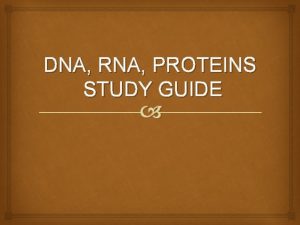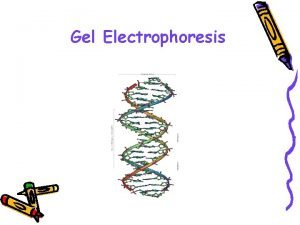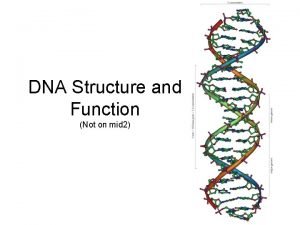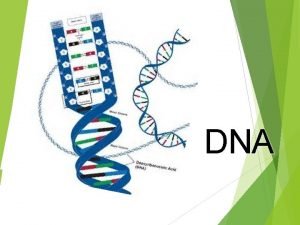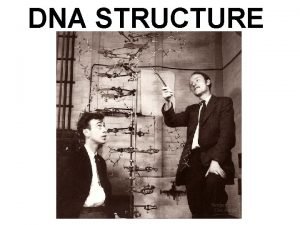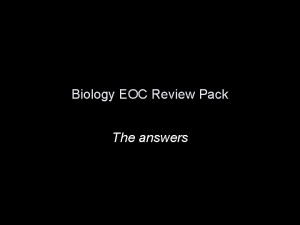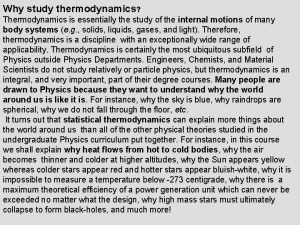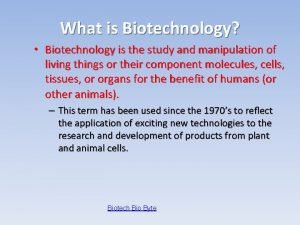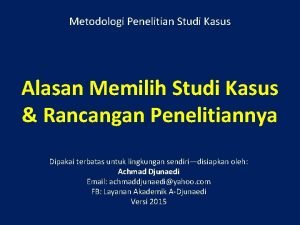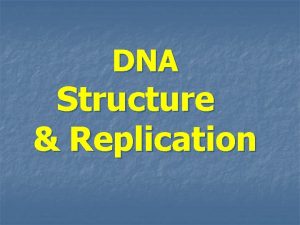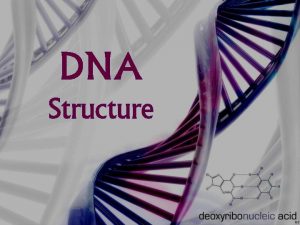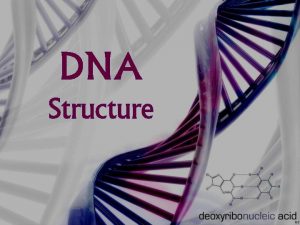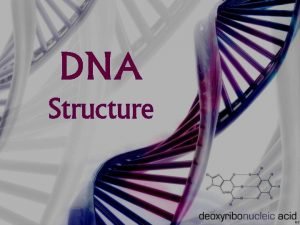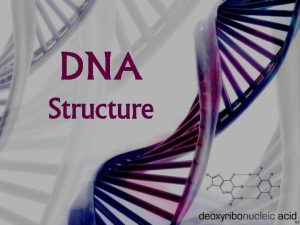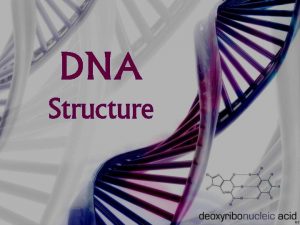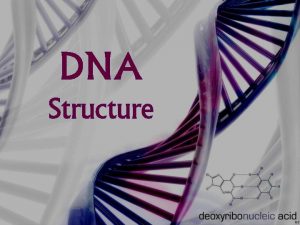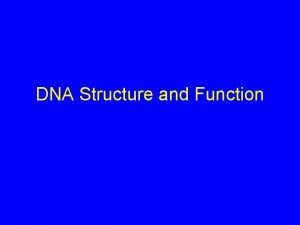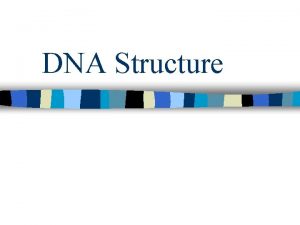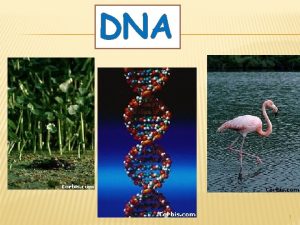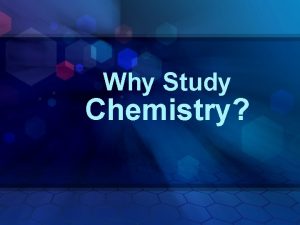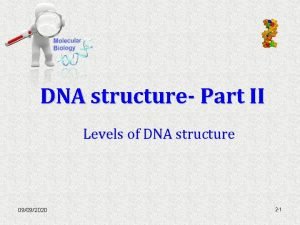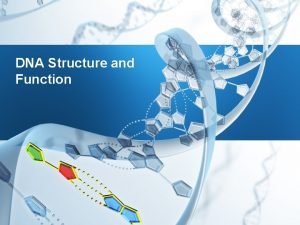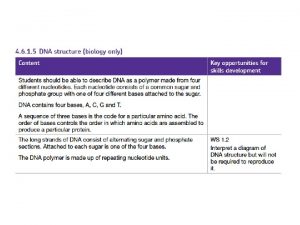DNA STRUCTURE Why Do We Study DNA DNA

























- Slides: 25

DNA STRUCTURE

Why Do We Study DNA? DNA We study DNA for many reasons: • It’s central importance to all life on Earth • Medical benefits such as cures for diseases • Better food crops 2

Chromosomes and DNA • Our genes are on our chromosomes. • Chromosomes are made up of a chemical called DNA. 3

Watson & Crick • Built their work off of x-ray crystallography performed by Rosalind Franklin • Created an accurate model of DNA structure • Awarded Nobel prize in 1967

The Shape of the Molecule • DNA is a very long polymer • The basic shape is like a twisted ladder or zipper • This is called a double helix 5

DNA Structure • DNA is often called the blueprint of life. • In simple terms, DNA contains the instructions for making proteins within the cell. • A molecule of DNA is made up of millions of tiny subunits called Nucleotides • Each nucleotide consists of: 1. Phosphate group 2. Pentose sugar 3. Nitrogenous base

Nucleotide Structure Phosphate Nitrogenous Base Pentose Sugar

�The phosphate and sugar form the backbone of the DNA molecule, whereas the bases form the “rungs” �There are four types of nitrogenous bases.

Four Nitrogenous Bases DNA has four different bases: C • Thymine T • Adenine A • Guanine G • Cytosine 9

Thymine and Cytosine are PYRIMIDINES • Thymine and cytosine each have one ring of carbon and nitrogen atoms. N O O C C C N N C C thymine O C C N C cytosine 10

Adenine and Guanine are PURINES • Adenine and guanine each have two rings of carbon and nitrogen atoms. N N C Adenine N C C N O N N C C C C N Guanine C N N C 11

Hydrogen Bonds N C N N C C N C O N C C C C N • The bases attract each other because of hydrogen bonds • Hydrogen bonds are weak but there are millions and millions of them in a single molecule of DNA • The bonds between cytosine and guanine are shown to the right with dotted lines N O 12

Hydrogen Bonds cont. N • When making hydrogen bonds, cytosine always pairs up with guanine • Adenine always pairs up with thymine (as shown to the right) N C C C O C N N C 13

Nitrogenous Bases cont. �Each base will only bond with one other specific base. �Adenine (A) �Thymine (T) Form a base pair �Cytosine (C) �Guanine (G) Form a base pair

One Strand of DNA nucleotide • One strand of DNA is a polymer of nucleotides • One strand of DNA has many millions of nucleotides 15

One Strand of DNA cont. • The backbone of the molecule is alternating phosphates and deoxyribose sugar • The teeth are nitrogenous bases phosphate deoxyribose bases 16

Two Stranded DNA • Remember, DNA has two strands that fit together something like a zipper • Complimentary base paring between the nitrogenous bases hold the strands together 17

Chargraff’s Rule: Adenine and Thymine always join together A T Cytosine and Guanine always join together C G 18

Chargraff cont. • Erwin Chargraff • Determined that the number of Thymine in a molecule of DNA has to equal the number of Adenine due to strict base pairing rules • Number of Cytosine is equal to the number of Guanine

Base Pairing �To crack the genetic code found in DNA we need to look at the sequence of bases. �The bases are arranged in triplets called codons AGG-CTC-AAG-TCC-TAG TCC-GAG-TTC-AGG-ATC

Central Dogma DNA RNA Protein �A gene is a section of DNA that codes for a protein �Each unique gene has a unique sequence of bases �This unique sequence of bases will code for the production of a unique protein �It is these proteins and combination of proteins that give us a unique phenotype (an organism’s physical appearance)

Central Dogma cont. • DNA is stored inside the nucleus of eukaryotic cells • Because it cannot leave the nucleus a messenger molecule, RNA, has to be made in order to send the genetic blueprint to the ribosomes in the cytoplasm that do the building • Proteins do the work of the genetic blueprints

DNA Gene Protein Trait

Central Dogma cont. • Transcription = the process of using DNA to make complementary RNA – RNA uses the nitrogen base Uracil in place of Thymine to pair with Adenine • Translation = the process of using the RNA to make proteins

Your Task �Draw a flow chart to show to get from:
 Hey bye bye
Hey bye bye Don't ask why why why
Don't ask why why why Dna polymerase function in dna replication
Dna polymerase function in dna replication Bioflix activity dna replication nucleotide pairing
Bioflix activity dna replication nucleotide pairing Coding dna and non coding dna
Coding dna and non coding dna Replication process
Replication process Dna rna protein synthesis homework #2 dna replication
Dna rna protein synthesis homework #2 dna replication Dna rna and proteins study guide answers
Dna rna and proteins study guide answers Dna protein synthesis study guide answers
Dna protein synthesis study guide answers Case series
Case series Retrospective cohort study
Retrospective cohort study Work study and method study
Work study and method study Marty lobdell
Marty lobdell In area
In area Time study objectives
Time study objectives Difference between time study and motion study
Difference between time study and motion study Gel electrophoresis why do smaller fragments move faster
Gel electrophoresis why do smaller fragments move faster Dna negative charge
Dna negative charge Why is dna important
Why is dna important Why is dna a polymer
Why is dna a polymer Why is dna replication considered semiconservative
Why is dna replication considered semiconservative Why dna is more stable than rna
Why dna is more stable than rna Why study thermodynamics
Why study thermodynamics Why study financial institutions
Why study financial institutions What is biotechnology
What is biotechnology Alasan menggunakan studi kasus
Alasan menggunakan studi kasus







